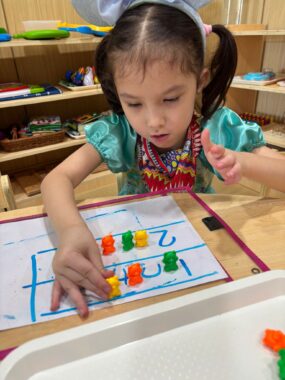How AADC deficiency inspired a learning center’s summer program
How special instruction is helping our daughter transition to homeschooling
Written by |

When our daughter, Rylae-Ann, was diagnosed with aromatic l-amino acid decarboxylase (AADC) deficiency, my wife, Judy, and I stepped into a world few people know about. This rare genetic condition affects the brain’s ability to produce essential neurotransmitters, leaving children with severe motor, developmental, and autonomic challenges.
During her early years in Singapore, Rylae-Ann couldn’t sit up, swallow properly, or communicate verbally. Life became a daily routine of navigating uncertainty until a breakthrough changed everything.
At just over 1 year old, Rylae-Ann received an experimental gene therapy in Taiwan. The transformation was slow but extraordinary. Over time, she gained strength, speech, movement, and independence. Her milestones were hard-won and deeply celebrated. Eventually, she reached a point where she could attend school and function independently in a classroom. It was a dream come true.
But despite all the progress, another challenge emerged. It’s one that many parents of children with rare diseases will understand. While Rylae-Ann had made incredible gains, she still faced an academic achievement gap because of her delayed start to school. In a traditional classroom, there wasn’t enough tailored support to help her close that gap.
She was capable, independent, and eager to learn. However, the pace and structure of school weren’t designed for her unique journey. We faced a tough decision.
After much reflection, we realized that our combined experience as parents, educators, and advocates gave us something powerful: the ability to create a learning environment specifically for Rylae-Ann’s needs. So with hearts full of hope and minds focused on the future, we decided to transition her to homeschooling.
To ease that transition for Rylae-Ann and us, we launched a pilot summer program at Pathway Educational Center, a learning center Judy recently opened. What started as a personal solution quickly grew into something much bigger.
A summer of discovery and joy

Rylae-Ann learns math concepts with manipulatives and a whiteboard. (Photo by Richard E. Poulin III)
The first week at Pathway was nothing short of magical. The classroom we designed was bright, warm, and filled with books, sensory-friendly materials, art supplies, and hands-on learning tools. When Rylae-Ann walked in, her face lit up, as did the faces of the other students.
Each morning began with circle time, where we shared thoughts, sang songs, and practiced communication skills. For Rylae-Ann, it was a moment to feel seen and heard, to start her day with confidence and connection.
Academic lessons were individualized and playful. Reading came alive through interactive phonics games and storytelling. A book about Rylae-Ann and her rare disease was even the featured book of the day! Math was taught using real-world objects she could touch and explore. The goal wasn’t to keep up. It was to grow.
In the afternoons, the curriculum shifted to focus on creativity and physical engagement, incorporating activities such as art, music, cooking, and outdoor play. One highlight was a STEAM project (science, technology, engineering, arts, and mathematics) where students built simple machines using everyday items. Watching Rylae-Ann proudly present her creation reminded us exactly why we’d begun this journey.
More than anything, Rylae-Ann was excited to return each day. She felt supported, understood, and free to learn at her own pace. For Judy, who is leading this transition and drawing from her background in education, the summer program was also a space to observe, adapt, and shape the curriculum based on what worked best for our daughter.
Why Pathway matters
Pathway wasn’t built from a business plan. It was built from love, necessity, and a deep understanding that every child learns differently. For children like Rylae-Ann, the traditional path doesn’t always fit. But that doesn’t mean they can’t thrive. Sometimes, they just need a different road.
We know we’re not the only ones searching for this kind of learning experience. That’s why we’re opening our doors to other families who may be facing the same decision we did. Whether it’s because of a rare disease, learning differences, or simply the desire for a more personalized educational approach, Pathway is here for other parents facing the same dilemma.
This journey began with one little girl and a big dream. Now, it’s a growing community committed to giving every child the chance to reach their full potential in their own time and in their own way.
When the world doesn’t offer the path you need, sometimes the most powerful thing you can do is create your own.
Note: AADC News is strictly a news and information website about the disease. It does not provide medical advice, diagnosis, or treatment. This content is not intended to be a substitute for professional medical advice, diagnosis, or treatment. Always seek the advice of your physician or other qualified health provider with any questions you may have regarding a medical condition. Never disregard professional medical advice or delay in seeking it because of something you have read on this website. The opinions expressed in this column are not those of AADC News or its parent company, Bionews, and are intended to spark discussion about issues pertaining to aromatic l-amino acid decarboxylase deficiency.





Leave a comment
Fill in the required fields to post. Your email address will not be published.